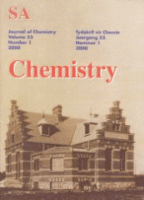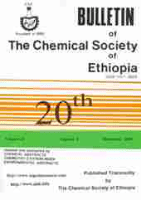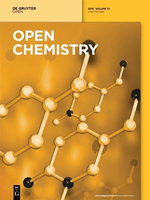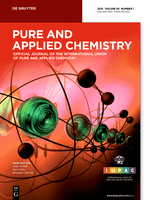
Chemija
Scope & Guideline
Publishing Excellence in Chemistry Research.
Introduction
Aims and Scopes
- Analytical Chemistry:
The journal frequently publishes studies on various analytical techniques, including gas chromatography and high-performance liquid chromatography, which are crucial for detecting and quantifying chemical substances in complex matrices. - Synthetic Chemistry:
A significant portion of the research involves the synthesis of new chemical compounds and materials, including nanoparticles and organic derivatives, highlighting innovative methods and potential applications in pharmaceuticals and materials science. - Environmental Chemistry:
Research addressing the chemical processes and impacts on the environment is prominent, focusing on pollution detection, degradation of hazardous substances, and the study of bioactive compounds in natural products. - Materials Chemistry:
The exploration of new materials, including hydrogels, nanoparticles, and catalysts, showcases the journal's commitment to developing advanced materials with applications in various fields, including energy, health, and technology. - Biochemistry and Medicinal Chemistry:
The journal also covers research related to the biochemical properties of compounds, their interactions, and potential therapeutic effects, particularly in the development of new drugs and bioactive substances.
Trending and Emerging
- Green Chemistry and Sustainable Practices:
There is a noticeable increase in research related to green chemistry principles, including the development of eco-friendly solvents and sustainable synthesis methods. This trend reflects a broader commitment within the scientific community to address environmental concerns. - Nanotechnology and Nanomaterials:
The synthesis and application of nanomaterials, particularly silver nanoparticles and their composites, are gaining traction. This emerging theme highlights the potential of nanotechnology in various fields, including medicine and environmental remediation. - Bioactive Compounds and Natural Products:
Research focusing on the extraction, characterization, and application of bioactive compounds from natural sources is on the rise. This trend signifies an increasing interest in utilizing natural products for health-related applications and functional foods. - Electrochemistry and Energy Storage:
Studies related to electrochemical processes, including the development of catalysts for energy conversion and storage, are emerging as a significant focus area, driven by the global need for sustainable energy solutions. - Interdisciplinary Approaches:
There is a growing trend towards interdisciplinary research that combines chemistry with fields such as biology, materials science, and environmental science, fostering innovative solutions to complex problems.
Declining or Waning
- Traditional Organic Chemistry:
Research focused solely on traditional organic synthesis methodologies appears to be waning as the field shifts towards more innovative and efficient synthetic strategies, such as microwave-assisted synthesis or green chemistry approaches. - Classical Analytical Techniques:
There is a noticeable decrease in publications centered around classical analytical techniques without innovative modifications. The trend is moving towards more advanced and integrated methods that enhance detection sensitivity and specificity. - Inorganic Materials without Functional Applications:
Studies that focus solely on the characterization of inorganic materials without exploring their functional applications seem to be decreasing, indicating a shift towards more applied research that emphasizes the utility of materials.
Similar Journals

SOUTH AFRICAN JOURNAL OF CHEMISTRY-SUID-AFRIKAANSE TYDSKRIF VIR CHEMIE
Catalyzing Change in the World of ChemistrySouth African Journal of Chemistry (Suid-Afrikaanse Tydskrif vir Chemie), published by Bureau Scientific Publications, is a pivotal open-access journal that has been disseminating groundbreaking research in the field of chemistry since its inception in 1996. With an ISSN of 0379-4350 and an E-ISSN of 1996-840X, this journal serves as a vital platform for researchers and professionals seeking to share their work and engage with the global chemistry community. Recognized for its significant contributions, the journal holds a Q3 quartile ranking in the miscellaneous chemistry category as of 2023 and ranks #216 out of 408 in General Chemistry according to Scopus. The South African Journal of Chemistry is dedicated to advancing knowledge in the discipline by publishing a wide array of articles, reviews, and studies that address pertinent chemical research and applications. With open access options available since 2000, it fosters a collaborative environment, ensuring that research is accessible to all, thereby enhancing the visibility and impact of chemists' work across South Africa and beyond.

EUROPEAN JOURNAL OF ORGANIC CHEMISTRY
Advancing the Frontiers of Organic ChemistryThe EUROPEAN JOURNAL OF ORGANIC CHEMISTRY (ISSN: 1434-193X; E-ISSN: 1099-0690), published by WILEY-V C H VERLAG GMBH in Germany, stands as a crucial platform for disseminating innovative research in the fields of organic, physical, and theoretical chemistry. With its inception dating back to 1998 and converging expertise until 2024, this esteemed journal has achieved a notable reputation, earning a Q2 rank in both Organic Chemistry and Physical and Theoretical Chemistry categories as of 2023, indicating its vital contribution to the academic community. Researchers and professionals will benefit from its rigorous peer-reviewed articles, which foster advancement in chemical sciences, while students can leverage its wealth of knowledge to enhance their learning. Although currently not an open-access journal, the content produced is invaluable for those looking to stay at the forefront of chemical research.

MENDELEEV COMMUNICATIONS
Pioneering Insights for the Chemistry Community.Mendeleev Communications, published by Elsevier, is a prominent journal within the field of chemistry that has been providing a platform for innovative research since its inception in 1991. Based in the Netherlands, this journal serves as a vital resource for researchers, professionals, and students looking to advance their understanding of miscellaneous chemistry topics. With a current Q3 ranking in the broad category of Chemistry (miscellaneous) and positioning within the 46th percentile of its field according to Scopus rankings, Mendeleev Communications is committed to disseminating high-quality, original contributions to the scientific community. While the journal is not currently an open-access platform, it ensures rigorous peer-review and editorial standards that contribute to its academic reputation. As it moves toward 2024, Mendeleev Communications continues to play a crucial role in fostering communication among chemists and promoting cutting-edge research that drives the discipline forward.

BULLETIN OF THE CHEMICAL SOCIETY OF ETHIOPIA
Empowering Global Research in Ethiopian ChemistryBULLETIN OF THE CHEMICAL SOCIETY OF ETHIOPIA (ISSN: 1011-3924; E-ISSN: 1726-801X), published by the Chemical Society of Ethiopia, serves as a pivotal platform for the dissemination of innovative research and developments within the field of chemistry. Since its inception in 1996 and now an open access journal since 2012, it has provided researchers, academics, and students with unrestricted access to critical studies and findings, thus fostering collaboration and the advancement of knowledge in the discipline. The journal's current standing in the Q3 quartile in the 2023 Chemistry category underlines its commitment to maintaining high academic standards, while its Scopus ranking, positioned at #250 out of 408 in general chemistry, showcases its growing influence and contribution to the scientific community. Hailing from Ethiopia and targeted toward a global readership, the journal aims to highlight local and international research, engaging scholars and practitioners alike in discussions that propel the science of chemistry forward.

Jordan Journal of Chemistry
Illuminating Chemistry: Open Access to Groundbreaking Research.The Jordan Journal of Chemistry is a prominent publication dedicated to advancing the field of chemistry in Jordan and beyond. Published by the Yarmouk University Deanship of Research & Graduate Studies, this journal serves as a platform for researchers, educators, and practitioners to disseminate their findings in a variety of chemistry sub-disciplines. Although currently classified in Q4 of miscellaneous chemistry and ranking within the 9th percentile according to Scopus, the journal plays a crucial role in fostering academic dialogue and collaboration in the region. With its ISSN 1814-9111 and E-ISSN 2079-7249, the Jordan Journal of Chemistry offers open access to researchers from diverse backgrounds, ensuring that critical research is both accessible and impactful. By bridging local studies with global scientific advancements, this journal is poised to contribute significantly to the growth and recognition of chemistry as a key scientific discipline in the region, with convergence efforts set from 2020 to 2024.

Frontiers in Chemistry
Pioneering Discoveries in the World of Chemistry.Frontiers in Chemistry is an esteemed and innovative Open Access journal published by FRONTIERS MEDIA SA, based in Lausanne, Switzerland. Since its inception in 2013, the journal has established itself as a leading platform for the dissemination of high-quality research across a broad spectrum of chemistry disciplines, achieving a notable Q1 classification in the miscellaneous chemistry category as of 2023. With an impressive Scopus rank, placing it at 72nd out of 408 in General Chemistry and falling within the 82nd percentile, Frontiers in Chemistry is committed to publishing significant findings that contribute to the advancement of the field. The journal's Open Access model ensures that research is freely accessible to all, fostering a greater exchange of knowledge and collaboration among researchers, professionals, and students globally. It covers a range of topics, from organic and inorganic chemistry to materials science and biochemistry, making it an essential resource for anyone seeking to stay at the forefront of chemical research.

Open Chemistry
Pioneering Open Access to Cutting-Edge Chemical InsightsOpen Chemistry, published by DE GRUYTER POLAND SP Z O O, is a distinguished peer-reviewed journal that has been serving the global chemistry community since its inception. With an ISSN of 2391-5420 and an E-ISSN also of 2391-5420, this open-access journal has been accessible to researchers and practitioners alike since 2015, ensuring a wide dissemination of high-quality research findings. Located in Germany, specifically at BOGUMILA ZUGA 32A STR, 01-811 WARSAW, MAZOVIA, POLAND, Open Chemistry aims to publish innovative research across various chemical disciplines, with special attention to miscellaneous chemistry and materials chemistry. It is currently ranked in the Q3 category for both fields as of 2023, reflecting its solid standing within the academic community, with specific ranks of 187/408 in General Chemistry and 153/317 in Materials Chemistry, corresponding to respective percentiles of 54 and 51. Open Chemistry not only enhances the accessibility of cutting-edge research but also serves as a vital resource for students, professionals, and scholars seeking to advance their knowledge in the rapidly evolving landscape of chemical sciences.

HELVETICA CHIMICA ACTA
Advancing the Frontiers of Chemical ResearchHELVETICA CHIMICA ACTA, published by WILEY-V C H VERLAG GMBH, stands as a pivotal journal in the fields of chemistry and chemical research. Established in 1918, this esteemed journal spans a diverse array of topics, including biochemistry, catalysis, drug discovery, inorganic and organic chemistry, as well as physical and theoretical chemistry. With influence reflected in its noteworthy Q2 and Q3 quartile rankings across these categories as of 2023, HELVETICA CHIMICA ACTA continues to capture the interest of the global scientific community. Although not an open-access journal, it remains accessible through various academic institutions, ensuring broad reach and collaboration opportunities. Researchers, professionals, and students alike will find its meticulously peer-reviewed articles critical for advancing knowledge and fostering innovation within the chemical sciences. As the journal converges toward 2024, it remains committed to publishing high-quality, impactful research that supports the evolution of chemistry across its multifaceted disciplines.

PURE AND APPLIED CHEMISTRY
Elevating Chemical Research to New HeightsPURE AND APPLIED CHEMISTRY is a highly regarded journal in the fields of chemical engineering and general chemistry, published by Walter de Gruyter GmbH. Since its inception in 1960, this journal has continued to foster advancements in chemical research and facilitate the dissemination of new knowledge through its rigorous peer-reviewed articles. With an impressive impact factor that places it in Q2 quartile rankings for both Chemical Engineering and Chemistry as of 2023, it holds a significant position in the academic landscape, attracting authors and contributors from around the globe. The journal’s unique focus on the practical applications of chemical research makes it indispensable for researchers, professionals, and students aiming to bridge theoretical knowledge with real-world applications. Although it is not open access, its impact is enhanced by its continued relevance and contributions to the ever-evolving field of chemistry. Researchers and practitioners alike will find in PURE AND APPLIED CHEMISTRY a critical resource for staying updated on key developments and innovative practices in chemistry and chemical engineering.

Bulletin of the University of Karaganda-Chemistry
Elevating Academic Discourse in the World of ChemistryBulletin of the University of Karaganda-Chemistry is an esteemed academic journal published by KARAGANDA STATE UNIVERSITY, focusing on the field of chemistry and related disciplines. With an ISSN of 2518-718X and an E-ISSN of 2663-4872, this journal aims to disseminate high-quality research articles, reviews, and scholarly discussions that contribute to the advancement of knowledge in chemistry. Although it has experienced a transition in its coverage from 2021 to 2022, the journal remains a significant platform for researchers and students alike, promoting open access to its valuable content. Despite its current Scopus rank of #379/407 in the general chemistry category, the Bulletin of the University of Karaganda-Chemistry serves as a vital resource for the academic community in Kazakhstan and beyond, fostering collaboration and innovation in various chemical research domains. Researchers, professionals, and students are encouraged to engage with the journal as it continues to evolve and contribute to significant scientific discussions.